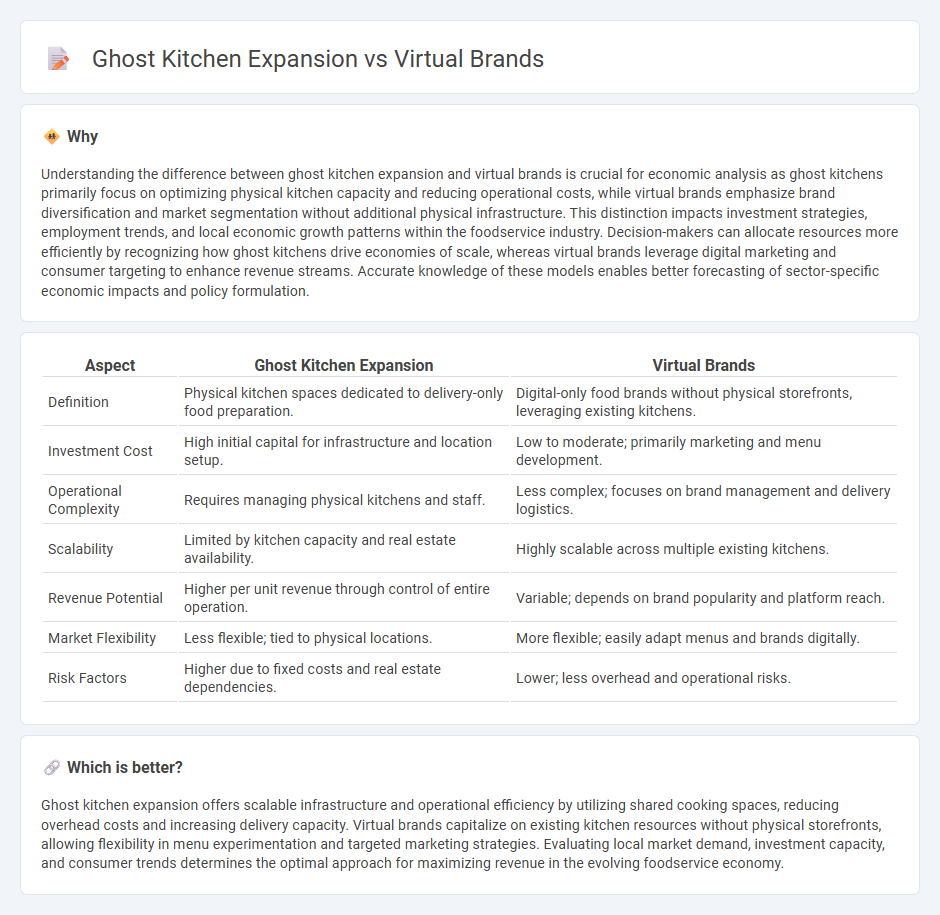
Ghost kitchen expansion drives efficient food delivery by utilizing shared commercial kitchen spaces optimized for multiple restaurant brands, reducing overhead costs and increasing operational scalability. Virtual brands leverage this model by creating targeted menus that cater to specific customer segments without the need for physical storefronts, enhancing market reach through digital platforms. Explore how these innovations reshape the food service economy and drive consumer convenience in the evolving marketplace.
Why it is important
Understanding the difference between ghost kitchen expansion and virtual brands is crucial for economic analysis as ghost kitchens primarily focus on optimizing physical kitchen capacity and reducing operational costs, while virtual brands emphasize brand diversification and market segmentation without additional physical infrastructure. This distinction impacts investment strategies, employment trends, and local economic growth patterns within the foodservice industry. Decision-makers can allocate resources more efficiently by recognizing how ghost kitchens drive economies of scale, whereas virtual brands leverage digital marketing and consumer targeting to enhance revenue streams. Accurate knowledge of these models enables better forecasting of sector-specific economic impacts and policy formulation.
Comparison Table
| Aspect | Ghost Kitchen Expansion | Virtual Brands |
|---|---|---|
| Definition | Physical kitchen spaces dedicated to delivery-only food preparation. | Digital-only food brands without physical storefronts, leveraging existing kitchens. |
| Investment Cost | High initial capital for infrastructure and location setup. | Low to moderate; primarily marketing and menu development. |
| Operational Complexity | Requires managing physical kitchens and staff. | Less complex; focuses on brand management and delivery logistics. |
| Scalability | Limited by kitchen capacity and real estate availability. | Highly scalable across multiple existing kitchens. |
| Revenue Potential | Higher per unit revenue through control of entire operation. | Variable; depends on brand popularity and platform reach. |
| Market Flexibility | Less flexible; tied to physical locations. | More flexible; easily adapt menus and brands digitally. |
| Risk Factors | Higher due to fixed costs and real estate dependencies. | Lower; less overhead and operational risks. |
Which is better?
Ghost kitchen expansion offers scalable infrastructure and operational efficiency by utilizing shared cooking spaces, reducing overhead costs and increasing delivery capacity. Virtual brands capitalize on existing kitchen resources without physical storefronts, allowing flexibility in menu experimentation and targeted marketing strategies. Evaluating local market demand, investment capacity, and consumer trends determines the optimal approach for maximizing revenue in the evolving foodservice economy.
Connection
Ghost kitchen expansion drives the growth of virtual brands by reducing overhead costs and enabling faster market entry. These kitchens leverage shared facilities and digital ordering platforms, increasing operational efficiency for virtual restaurant concepts. Data-driven insights from ghost kitchens optimize menu offerings and marketing strategies, fueling virtual brand scalability in the evolving economy.
Key Terms
Asset-light model
Virtual brands leverage the asset-light model by operating exclusively through delivery platforms without physical storefronts, significantly reducing overhead costs compared to traditional kitchens. Ghost kitchens, often shared commercial spaces, enable multiple virtual brands to scale rapidly by maximizing kitchen utilization and minimizing capital expenditure. Explore how asset-light strategies are transforming the foodservice industry and driving cost-efficient growth.
Market penetration
Virtual brands leverage existing kitchen infrastructure to rapidly increase menu offerings, capturing diverse customer segments without high capital investment. Ghost kitchens focus on dedicated cooking spaces optimized for delivery efficiency, enabling faster market penetration with reduced operational costs. Explore how these models uniquely drive expansion and influence market share growth.
Operational scalability
Virtual brands enhance operational scalability by leveraging existing kitchen facilities to diversify menus without the need for physical storefronts. Ghost kitchens optimize scalability through dedicated spaces tailored for delivery-only service, enabling higher order volumes and streamlined workflows. Explore how these models transform food service operations and drive scalable growth.
Source and External Links
What is a Virtual Brand? - A virtual brand is a food business that operates entirely online with no physical storefront, preparing food in shared or existing kitchens and selling exclusively through delivery platforms like DoorDash or Uber Eats.
What is a Virtual Brand? The Rise of Online-Only ... - Virtual brands are online-only restaurants that use existing kitchen capacity to reduce costs, minimize risk, and reach a wider audience through third-party delivery apps without needing dine-in space or extra staff.
America's 57 Most Exciting Virtual Brands - Examples of popular virtual brands in the US include MrBeast Burger, Krispy Rice (sushi), Plant Nation (vegan), and Bad Mutha Clucka (chicken), showcasing a wide variety of cuisines delivered exclusively via virtual kitchens.
 dowidth.com
dowidth.com